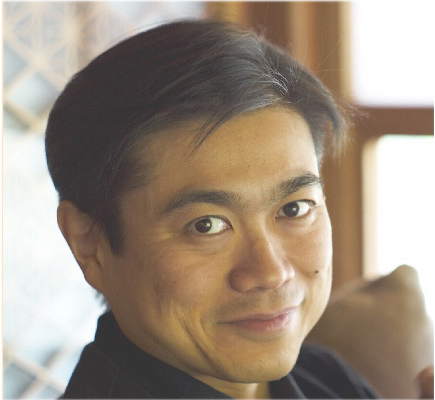Joi Ito, director of the MIT Media Lab, is an inspirational figure in the worlds of tech and design. Ito was an early investor behind Flickr and Twitter, and he has played a role in many other tech startups and nonprofit initiatives. He dropped out of college twice, but his personal vision has attracted the attention of some of the best minds around the world.
A notable crowd was in attendance to hear Ito’s keynote launch of the four day forum IDEAS CITY, on May 1st. Ito is the kind of thinker people look to in times of rapid change, and Cooper Union’s historic Great Hall, built in the mid-19th century, provided a resonant setting for a talk about the future.
‘From BI to AI’
After sharing a joke with the audience, Joi neatly dove into his theme: the untapped capital of the internet. He pointed out that the world has evolved from ‘BI to AI’ — before and after internet.
Life in BI was slow and centralized. Experts were the sources of authority, and the distribution of knowledge was from top to bottom. Prior to the internet, innovation was costly, inflexible, and time consuming. Corporations often worried about the substantial risks involved in their investments and developments. Without constant feedback, end products risked misalignment with market needs. In this environment, large corporations often felt reluctant to make new adjustments because they wanted returns on their initial investments, instead of providing optimal products, or services.
In AI, life is fast-paced, information is complex, and knowledge is disseminated from the bottom up. In Joichi’s own words, the theme of AI is “anarchic.” Rapid connectivity empowers people to share, organize, and act quickly to the degree that no single entity (governments, corporations, or individuals) can fully control the accesses to knowledge and information. In fact, open-source, or open-content formats have forced businesses to adapt bottom-up designs and provide competitive pricing. Since the capacity of information technology doubles roughly every two years (according to Moore’s law), the cost of innovation has gone down drastically.
New World, New Attitude & New Approach
Open and low-cost innovation equals opportunities. Joichi encourages individuals to take risks and to become entrepreneurs. When I asked if that includes dropping out before finishing a degree, he clarified that he didn’t encourage students to drop out of college — but to embrace risk-taking afterwards.
However, he repeatedly emphasized the difference between theory and practice. AI, our turbulent era, is inherently fast paced and unpredictable. One cannot afford to theorize their ideas and hope for the market to follow. Entrepreneurs need to face reality by directly testing their products and services. Fail, learn, and then adjust accordingly.
“Agility” and “resilience” are critical traits. Google did not have a business plan at the early stages of the company’s development because it did not know where the business model for search was, until the service evolved. YouTube, which originally integrated a dating site with a self-made video platform in 2005, failed miserably at its early launches. The founders cried for a week, made quick adjustments of the ideas and became successful. Entrepreneurs often cannot pick the winning idea at the very first try, and they simply need to stay flexible and keep trying.
Joichi also touched on the connection between needs and services. In the business world, products and services need to address creativity and locality. He gave an example about Detroit; local residents do not welcome corporations, who romanticize the region, making big changes without engaging the communities. Applying the same concept to governance, a group of concerned individuals, who did not have any disaster experience prior to the Fukushima Daiichi nuclear disaster, did better jobs than the Japanese government. They achieved success by driving a car around to collect radiation data and provide constructive assistance to the victims.
Future Opportunity
3D printing is the next big thing. 3D printing encourages customization and creative expression; it will manifest the trend of “self-learning” in the information age. With 3D printing, hardware startups can act similarly to Internet startups; the ability to fabricate designs on site will permit low production and innovation costs while allowing a high level of creative customization.
For Ito, the bottom line of the future is: Think big, write your own rules, design your own things and print your own stuff.
9 Principles:
Let’s summarize Joichi’s wisdom with his 9 principles:
Disobedience over compliance: Learn the system and find ways to innovate beyond it.
Emerge over authority: Do not let the authority or norms to limit your potential and creativity.
Practice over theory: Build first, theory later; build prototypes first, draft business plans later.
Resilience over strength: Test and fail quickly to understand the market, then make new adjustments accordingly.
Risk over safety: Do not let over-protection take away your learning opportunities.
Pull over push: Start your project first, and then pull resources together while you need; do not plan for everything at the beginning.
Compass over map: Be creative; draw your own maps.
Embrace serendipity: Embrace unexpected changes and events; read more about the 3M’s Post-It Notes story.
Pattern recognition: Keep your vision and thinking open and flexible; laser focus may kill innovation at the development stages.
__
Ito provided a jolt of enthusiasm to the launch of the four day IDEAS CITY event; subsequent panels (as covered in City Atlas, including panels on Waste, Play, and Youth) each detailed the challenges the future brings. One hopes the ingenuity of the AI world, so brightly described by Joi Ito, can be a model for solutions across all aspects of the urban future: that takes determination too, as described by the writer Bruce Sterling in a recent talk in Berlin. Sterling’s very hard question begins at about 6:20.
